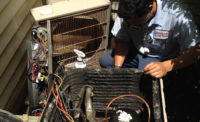
The real question is how to position your contracting company to take advantage of it. The days of burying your head in the sand and saying, “None of my customers use the Web,” are gone. Instead, we need to better understand the Internet and how it is used by our customers to determine its place in our business.
The Internet has changed the way many industries do business. And, certainly, its economies and communication abilities make it more useful to some than others. For example, it’s great for purchasing books or music, but a consumer can’t buy a furnace or download a technician to perform maintenance. So, exactly what is it that the Internet can do for an HVAC contractor? Surprisingly, it’s a question being asked by many who have Web sites as well as by those who are considering the Internet.
The answer to that question is best found by turning your thinking around. Understanding what the Internet can do for you is directly related to what your Web site can do for your customer. After all, isn’t identifying and meeting customer needs what selling has always been about? The most important thing we need to consider, then, is what’s in it for them.
In a word, information.
Most Adults Use The Web
According to the Harris Poll, today more than two-thirds of all U.S. adults use the Internet. Each year, this group becomes more representative of the population at large, although still skewed toward the younger, more educated, and affluent. It’s changing fast. Did you know that senior citizens are one of the fastest growing segments of Web users?Internet users are becoming what are described as “stealth” consumers — those who do their homework and don’t contact you until they are well on the way to making a purchasing decision. They have money to spend, but are discerning about on what and with whom they’ll spend it.
The stealth consumer is not merely a browser. He or she is a researcher. And, the higher the ticket price, the more research they’re willing to do. They are looking for information that is current, focused, and educational.
But it is not just a list of features they are seeking; they want to understand why these features are important and get an idea of with whom they want to work.
Just like your own, the Internet consumer’s time is precious. Like it or not, their process of elimination has started and you are being judged by your Web site. As we know, all purchasing decisions are based on perceptions. If you have a Web site, what type of impression does it make? When you browse, don’t you make quick judgments about companies based on how professional they appear?
So, who is the typical HVAC Web site browser and what do they typically find? First, there are only two types of people who purposely go to an HVAC Web site. One is in the market for your services and the other is your competition. We may as well admit it — HVAC Web sites are not the first choice for a bored Web browser to surf. The good news is that when a consumer visits your site, the only reason for them being there is that they are in the market for something you sell. So don’t let low visitor counts discourage you. Those who visit should be considered as highly qualified leads.
Compare It To Direct Mail
To understand what a Web site visitor means to you financially, compare it to direct mail response. After all, just like a Web visitor, doesn’t a direct mail response represent those who are interested in your product or services? Since the typical direct mail response is approximately one-fourth of one percent, this means you have to send 400 letters to find one potential consumer interested in your product. If a letter typically costs about 40 cents to mail, sending 400 letters to find that one potential customer will cost you $160.Apply this $160 per visitor to your Web site, and you’ll see the value of a Web site in a whole new light. Even 10 visitors a month can translate into $1,600 of avoided marketing costs. The problem is, however, most HVAC Web sites aren’t designed to court these customers effectively, if at all.
The vast majority of HVAC Web sites consist of one to five pages covering who they are, what they do, when they’re available, the brands they offer, and how to contact them. These Web sites are really not much more than digital billboards to be polite, or electronic refrigerator magnets to be more precise. When you think about it, if this was all a visitor to your Web site wanted to know, wouldn’t the Yellow Pages have been a better choice? At least (unlike the typical HVAC Web site), it’s sure to be updated once a year.
The unfortunate, but ironic, truth is, if the typical HVAC contractor searched the Internet for information about an industry he knew little about, and came across a Web site like his own, he too would move along. A good test of how you really view your Web site is to ask yourself this question: When was the last time you referred a customer to your Web site for more information? Yet one of the most effective uses of a well-conceived Web site is to refer every customer to it who schedules a quote with you. If your Web site leaves them with an impression of being organized and professional, you’ve already set the standard for others who may be invited to quote.
When evaluating your Web site, don’t confuse putting a link to a manufacturer’s site with providing real information. In many cases, this is at best a shortsighted solution to a lack of real content, and at worst a big mistake. The danger of sending a potential customer to a manufacturer’s Web site is that they will find a “dealer locator” that is more than happy to steer them into the hands of local competition with the same product. Besides, you’re the one who marketed your site to get them there, why do you want to send them away? This is not why you create a Web site.
Not all HVAC contractor Web sites are so limited. Recognizing that the Internet is a given in the future of communication, a few forward-thinking HVAC companies have invested some serious resources in their Web sites, and it shows. But, such is not the luxury of the average HVAC dealer. And, at this stage of the Internet’s growth, it’s doubtful whether those who have invested heavily to own a more comprehensive Web site are satisfied with the return on their investment. However, they will be at the head of the pack as the momentum shifts.
Another consideration is, no matter the size or quality of your Web site, you still have to contend with the ongoing effort and cost required to keep it current. This is probably the biggest problem faced by all small businesses with a Web site. Here we have a communication vehicle where content can be updated in real-time, yet the only time most sites reflect what’s currently happening in your business is the first month after they’re launched. Unless you have the talent to do it yourself, it doesn’t take long to discover that every update will cost you at a minimum $60 to outsource.
It’s not unusual when browsing HVAC sites to find coupons that expired three to four years ago and nothing reflecting that the rest of the information is up to date. Once a visitor realizes this, they leave wondering how well you attend to other aspects of your business. Just like you wouldn’t subscribe to back issues of your newspaper; your customer needs to see that your Web site is maintained and up to date — not just “old news.”
Twelve Tips To A Better Site
Here are 12 ideas of what I believe is needed to create a more effective HVAC Web site:1. Supply content that provides answers to common questions. Remember, your site needs to be a resource for your customers.
2. Make sure your site has a clean, easy to follow menu system. You should be able to get anywhere, from anywhere.
3. A search function is a must. Remember, they don’t know all the terms we do, otherwise they wouldn’t need us. Facilitate the use of your site any way you can.
4. Include pictures that represent your company, not just the products you sell. People deal with people. Don’t just show a humidifier; show your people installing one.
5. Develop a home page that greets them as friends. If they just wanted lists of what you do, they can go to the Yellow Pages easier. Use many pictures and change them regularly.
6. If you take pictures of your jobs, post them. What could be more useful than an online photo album of happy customers with new equipment?
7. Post all complimentary comments and testimonials. What good are they on your bulletin board? Put them where the world can see them!
8. Provide forms to collect required information for scheduling or to answer questions. Facilitate communication. Ask for the information you need. Which brings us to our next point…
9. Be sure to pay attention to every communication your site generates. An ignored customer is now someone else’s customer. “No response” is the number one complaint in dealing with small business Web sites.
10. Use a Web provider that makes provision for frequent updates without additional cost. Nothing is more of a disincentive to an effective Web site than knowing that you are “running up a tab” by keeping it fresh.
11. Use a Web provider that offers customer support. This is essential since you’re not an expert. Understanding what it takes to be on the Web is a learning “cliff” not a “curve.”
12. Collect visitor statistics. How will you know if you’re succeeding if you don’t know what’s happening.
Some of you may look at suggestions as these as too expensive or unattainable. However, as the Internet industry has matured, companies like mine have targeted certain industries and created platforms that not only provide content and simplified Web site customization features, but bring an economy of scale to the picture as well.
In many cases, you can create a professionally designed Web site with over a hundred pages of consumer content for less than you charge for a single service call. One of the many benefits of this approach is that your site is always getting updated and improved as part of the package, so you don’t have to worry about keeping up with technology.
In a nutshell, before you determine your company’s Internet strategy, you have to take into account not only creation costs, but all the costs, skills, and tools associated with keeping your Web site relevant. Whether you decide to “lease” or build your site, in order to be effective, you have to not only provide content, but commitment as well. However, the payoff for that commitment will be huge.
Remember, it’s better to grab the bull by the horns now, than follow it later with no idea of what you’re stepping into.
Squires is president of Online-Access Inc., Port Huron, Mich., a company specializing in providing easily edited Web sites for small businesses. For more information, call 810-985-6603 or visit www.online-access.com.
Publication date: 03/24/2003







Report Abusive Comment